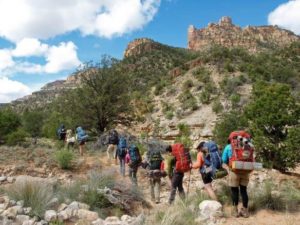
My experience backpacking through Dark Canyon Wilderness, waking each morning to the sight of the grand, high walled sandstone walls painted by desert varnish and the various green hues of the diverse set of plant species like ponderosa and pinon pines, aspen, doug fir, junipers, and more lush looking shrubs and plants then you would ever imagine could grow in a desert area, challenged my naturalist skills while teaching me about everything from stream ecology to land management and policy.
I first learned the basics of the 1964 Wilderness Act in a classroom in Wisconsin. I enjoyed learning about the history and politics of the eventual creation of this act, but reading material about contemporary land management challenges regarding Designated Wilderness Areas while in the state of Utah hiking through one of its strikingly gorgeous sets of canyons peaked my interest about the future of Wilderness. I didn’t have many questions about land managed for wilderness characteristics after sitting in a desk in the middle of a campus at least five hours south of a designated area. Dark Canyon awakened an interest of thinking about the fine details of who manages this land, how it’s managed, and what kind of characteristics, components, and systems these places ought to contain.
Before starting this excursion, if you asked me about my thoughts regarding certain types of public land usage and management, I most certainly would not have had many impassioned things to say. There was something about being in a remote place capable of offering solitude, journeying up side canyons for water most days, noticing which plants grew where and why, and finding worthy branches to hang our food each night and retrieve it each morning instead of having it readily available to my fingertips within seconds from the pantry, reminding me that my access to food and water for survival is not inherent or guaranteed just because I am human, that opened my eyes to importance of how people value land and for what reasons. These experiences helped me understand that my actions are not without consequence, and how societies perceive the importance of areas like Dark Canyon matters for the future of species from every biologic kingdom.
A few months ago, I read a Smithsonian article about a proposition from biologist and naturalist E.O. Wilson that 50% of the world’s land should be designated as human-free natural reserves. Half of the world treated as Wilderness – is that possible? What would it look like, and how could we convince private land owners that their land should be included? Should this proposition that half of the world must be free from the kind of development and impact humans impose, how might our cities, communities, priorities and lifestyles change? What legislative changes must occur, and how might we question our ideas and expectations about wilderness?
A book detailing Wilson’s argument and proposal published in March is on my list to read when I get home, but as I embark on our final section canoeing through Labyrinth Canyon, I’ll think about how the past ideas of wilderness allow me to explore these places today. I will appreciate the experience these wonderful landscapes provide; yet, I will remain critical about how humans think of wild and natural places, ponder what the next steps of land management could and should accomplish, and hope to discover how I can positively impact the future of diverse kinds of land this world encompasses.